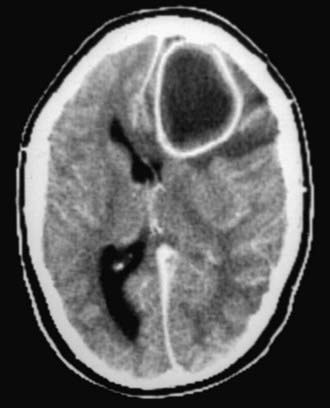Chapter 596 Brain Abscess
Diagnosis
The peripheral white blood cell count can be normal or elevated, and the blood culture is positive in 10% of cases. Examination of the cerebrospinal fluid (CSF) shows variable results; the white blood cells and protein may be minimally elevated or normal, and the glucose level may be low. CSF cultures are rarely positive; aspiration of the abscess is much more likely to establish a bacteriologic diagnosis. Molecular diagnostics with PCR are being evaluated to establish a bacterial etiology in aspirates from brain abscesses. Because examination of the CSF is seldom useful and a lumbar puncture may cause herniation of the cerebellar tonsils, the procedure should not be undertaken in a child suspected of having a brain abscess. The electroencephalogram (EEG) shows corresponding focal slowing, and the radionuclide brain scan indicates an area of enhancement due to disruption of the blood-brain barrier in >80% of cases. CT with contrast and MRI are the most reliable methods of demonstrating cerebritis and abscess formation (Fig. 596-1). MRI is the diagnostic test of choice. The CT findings of cerebritis are characterized by a parenchymal low-density lesion, and MRI T2 weighted images indicate increased signal intensity. An abscess cavity shows a ring-enhancing lesion by contrast CT, and the MRI also demonstrates an abscess capsule with gadolinium administration.
Brook I. Aerobic and anaerobic bacteriology of intracranial abscesses. Pediatr Neurol. 1992;8:210-214.
Goodkin HP, Harper MB, Pomeroy SL. Intracranial abscess in children: historical trends at Children’s Hospital Boston. Pediatrics. 2004;113:1765-1770.
Masalma A, Armougom F, Scheld WM, et al. The expansion of the microbiological spectrum of brain abscesses with use of multiple 16S ribosomal DNA sequencing. Clin Infect Dis. 2009;48:1169-1178.
Saez-Lloreus XJ, Umana NA, Odio CN, et al. Brain abscesses in infants and children. Pediatr Infect Dis J. 1989;8:449-458.
Sjolin J, Lilja A, Erikson N, et al. Treatment of brain abscess with cefotaxime and metronidazole: prospective study on 15 consecutive patients. Clin Infect Dis. 1993;17:857-863.
Smith RR. Neuroradiology of intracranial infection. Pediatr Neurosurg. 1992;18:92-104.
Yogev R, Bar-Meir M. Management of brain abscesses in children. Pediatr Infect Dis J. 2004;23:157-159.







